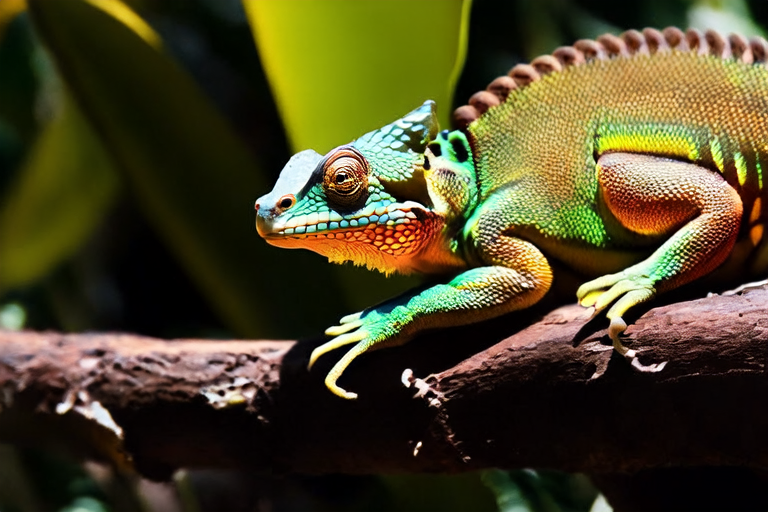Comprehensive Guide to Chameleon Care
Introduction: Chameleons are fascinating reptiles that captivate many with their unique appearance and behavior. However, they require specific care to thrive in captivity. This guide covers essential topics such as habitat setup, diet and nutrition, handling techniques, common health issues, and signs of stress or illness.
Habitat Setup
Enclosure Size
Chameleons need spacious enclosures to mimic their natural environment. The minimum size for a juvenile chameleon is 18 inches wide by 18 inches deep by 36 inches tall. For adults, a 24 inches wide by 24 inches deep by 48 inches tall enclosure is recommended. Larger enclosures are always better, providing more space for climbing and exploration.
Lighting
Proper lighting is crucial for chameleons’ health. UVB light is necessary for calcium absorption and overall well-being. Use a high-quality UVB bulb designed for reptiles, and place it within 6-12 inches of the basking branch. Replace the bulb every six months to ensure optimal output. Full-spectrum lighting should be provided for 10-12 hours per day, simulating natural daylight cycles.
Temperature
Maintaining appropriate temperatures is vital for chameleons’ digestion and metabolism. A gradient should be established with a basking spot reaching 90-95°F (32-35°C) and cooler areas around 70-75°F (21-24°C). Use a thermometer to monitor these temperatures accurately. Avoid placing the enclosure near windows or heat sources that could cause temperature fluctuations.
Humidity
Chameleons thrive in humid environments, but excessive moisture can lead to respiratory infections. Aim for humidity levels between 50% and 70%. Mist the enclosure twice daily using a spray bottle, focusing on leaves and branches. Alternatively, use a misting system or humidifier to maintain consistent humidity levels. Ensure proper ventilation to prevent stagnant air.
Diet and Nutrition
Chameleons are insectivores, primarily feeding on live insects. Offer a variety of appropriately sized prey items, including crickets, dubia roaches, silkworms, and hornworms. Dust the insects with a calcium supplement two to three times weekly and a multivitamin once a week. Gut-load insects by feeding them nutritious food before offering them to your chameleon. Provide clean, fresh water daily in a shallow dish or drip system.
Handling Techniques
Chameleons are delicate creatures and should be handled gently. Always support their body, especially their legs and tail, to prevent injury. Use a soft cloth or paper towel to catch them, avoiding sudden movements. Limit handling to a few minutes at most, as excessive handling can cause stress. Never handle a chameleon after feeding, as this can lead to regurgitation.
Common Health Issues
Metabolic Bone Disease (MBD)
MBD is a serious condition caused by calcium deficiency. Symptoms include lethargy, weak limbs, swollen joints, and difficulty climbing. Prevent MBD by providing adequate UVB lighting, dusting insects with calcium supplements, and ensuring proper humidity levels.
Respiratory Infections
Chameleons are susceptible to respiratory infections, often indicated by labored breathing, mucus discharge, or open-mouthed breathing. Maintain proper humidity levels and avoid drafts. If symptoms persist, consult a veterinarian specializing in reptiles.
Parasites
Parasites can be introduced through contaminated prey or unsanitary conditions. Regularly check your chameleon’s feces for parasites and treat accordingly under veterinary supervision. Keep the enclosure clean and free from debris.
Signs of Stress or Illness
Behavioral Changes
Monitor your chameleon’s behavior for any changes. Signs of stress or illness include lethargy, loss of appetite, hiding excessively, or aggression. Address these issues promptly by reviewing the enclosure setup and consulting a veterinarian if necessary.
Physical Symptoms
Pay attention to physical symptoms such as weight loss, swollen eyes, or discoloration. These may indicate underlying health problems requiring immediate attention.
Tips for Beginners
Start with a healthy, captive-bred chameleon from a reputable breeder. Research extensively before purchasing supplies and setting up the enclosure. Join online forums and local clubs for support and advice. Be patient and observant, adjusting the habitat and care routine as needed.
Tips for Advanced Owners
Consider breeding chameleons responsibly to contribute to conservation efforts. Explore advanced husbandry techniques, such as creating custom enclosures or experimenting with different diets. Stay updated on the latest research and best practices in chameleon care.
Conclusion: Proper care for chameleons involves creating a suitable habitat, providing a balanced diet, handling them gently, recognizing signs of stress or illness, and addressing common health issues. By following this comprehensive guide, both beginners and experienced owners can ensure their chameleons live long, healthy lives.
